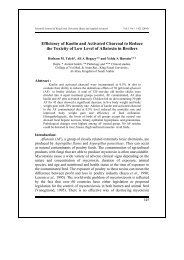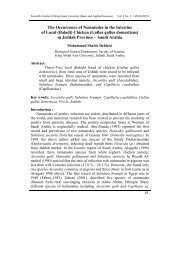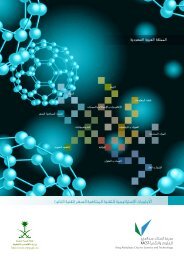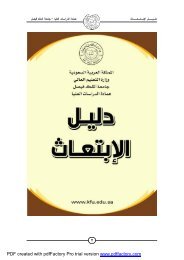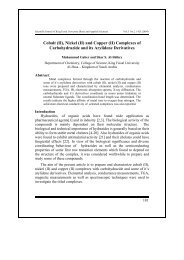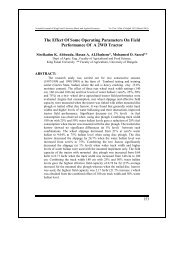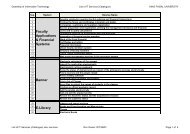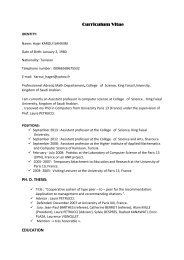142 <strong>Gifted</strong> <strong>Child</strong> <strong>Quarterly</strong> 54(2)Table 2. Respondents and Duration of PTAT NarrativesDuration ofPrivate School Group PTAT Cards (C) Duration of Stories (min:s) Public School Group PTAT Cards (C) Stories (min:s)Pink Princess, 4 C 1-21 27:39 Jaycee, 4 C 1-10 22:01C 11-21 22:52JM, 5 C 1-10 15:11 Jayjay, 5 C 1-21 34:27C 11-21 15:18Jaydee, 6 C 1-10 25:30 Ricky, 6 C 1-10 48:41C 11-21 22:34 C 11-21 23:35Kitty, 6 C 1-10 15:17 Katrize, 6 C 1-10 21:40C 11-21 17:22 C 11-21 46:44Amelia, 7 C 1-10 20:15 Vic, 7 C 1-10 24:17C 11-21 41:44 C 11-21 27:17JP, 7 C 1-19 28:38 Gerald, 7 C 1-10 35:09C 20-21 29:07 C 11-21 26:17Adrian, 8 C 1-10 22:44 Lynne, 8 C 1-10 32:51C 11-21 22:28 C 11-21 29:48Ysabella, 8 C 1-5 59:37 Lenny, 8 C 1-10 25:10C 6-11 58:59 C 11-21 22:48C 12 and 13 22:27 Frank, 8 C 1-10 26:54C 14-17 29:56 C 11-21 18:44C 18-21 23:33 Harry, 9 C 1-10 32:35Donny, 9 C 1-10 26:28 C 11-21 52:01C 11-21 26:55 Carmina, 9 C 1-10 40:18Gabriella, 9 C 1-21 55:45 C 11-21 31:11Jody, 9 C 1-10 37:56C 11-21 27:00Note: PTAT = Philippine Thematic Apperception Test.narratives. A citation refers to a particular story that containsa recurrent theme (e.g., mothers as homemakers). The templateof emergent themes was then used to review and codeall 484 stories. Parameters for each of the themes createdfrom the stories were not standardized, given the qualitativenature and grounded framework of the procedure. This is instark contrast to the traditional self-concept scales where thedomains are clearly delineated from the beginning. Here, thethemes have been generated from the stories themselves andhave been extensively discussed with the person doing theinterrater analysis (see next session).It is to be noted that although there were 49 citations offamilies helping each other, these 49 citations may havecome predominantly from one or two children. Furthermore,not all the 484 stories have families portrayed in them; hence,generating percentages was perceived to be unwise andmight have provided a skewed picture. However, the numericalfigures could assist us in noting trends with regard towhat the children appear to perceive as important. Furthermore,the demographics of the type of children who havehighlighted specific themes were identified. Hence, qualitativecomparisons could be made between private schooland public school children. Possible interpretations as towhy they may perceive this theme to be significant wereexplored and examples of their narratives are portrayed inthis article.The general focus of this article is not so much to come upwith a quantitative account of a largely qualitative procedurebut to develop a grounded analysis based on the children’sown narratives. I also want to demonstrate the intensity andquality of relationships shared among the characters in thePTAT stories and how it links to their socio-affective concernsas gifted children. Beyond the coding and numbers,however, I wanted to highlight the quality and depth of thesharing done by the children through their storytelling. Mostof the stories revealed actual links to their own fields ofexperience: their perceptions on school and education, theirideas regarding family relationships, peer interactions, andspirituality concerns. Through their storytelling, the giftedchildren were able to paint an even substantive and deeperportrait of what their private worlds were like, through thetales they wove.Interrater reliabilityA PhD candidate (Rater B) in clinical psychology consentedto analyze the PTAT narratives of six children (three from theprivate school setting and three from public school setting)
Garces-Bacsal 143for interrater reliability/coding. The six children were selectedwith an eye toward a representation of the following threeage-groups: 4-5, 6-7, and 8-9 years. Two children wereselected from each of the three age-groups: one from a privateschool group and another from the public school setting.Because not all 22 cards could be feasibly analyzed by theperson doing the interrater analysis, 7 PTAT cards werechosen for each of the six children (total of 42 stories) basedon their representativeness with regard to possible storiesthat could be gleaned from them. For a greater descriptionof the 7 chosen cards and the themes commonly foundamong them, see Appendix B. The selection of the 7 representativePTAT cards was approved by the supervisory teamof clinical practitioners who make use of the PTAT in theirown clinical practice.Although Rater B did not exhaustively include all possibleneeds and presses and themes and ending, everything thatshe noted were found in my analysis. I have also listed divergencesand parallelisms among the 42 stories for the 6 children.A major divergence was defined as an analysis that is diametricallyopposed to what the researcher noted down byway of analysis (totally opposite to how the characters arefeeling and thinking and major difference in the interpretationof the narratives). Minor divergence was defined as theanalysis having minor differences by way of wording butessentially and thematically alike. Out of the 42 stories, therewere no indications of a major divergence for themes, needs,presses, and endings. In 39 of the 42 cards, Rater B and I hadidentical interpretations of the story endings as well as citationsfor themes and storylines. The generated themes werediscussed with Rater B.Results and DiscussionThe narrative themes include the following: (a) FamilyRelationships, (b) Perception on School and Intelligence,(c) Predominant Characterization of Heroes, (d) Peer Relationships,and (e) Concerns Related to God and Spirituality.Points of divergence between the private and public schoolstories are explored.It was possible to obtain the exact number of citations pertheme through the use of the qualitative software nVIVO 7.0.These identified themes were grounded on the actual storiescreated by the children. Under the theme of Family Relationships,there were narratives indicating predominantly positivefamily connections. There were also indications of maritaldiscord and problems within the family in their narratives,particularly among children who are coming from singleparenthouseholds. Portrayal of mothers and fathers as wellas the strong presence of extended family and kin were likewiseevident in the tales.The children’s views on school and their thoughts regardingits importance could be gleaned from their stories, and aseparate category was created to document this. Anothermajor category was created to highlight how the childrencharacterize their heroes in their tales, and a separate categoryshowed how the gifted children characterize peer relationshipsin their stories. Although there were themes showinggood belongingness with a peer group, there were also indicationsof peer rejection. The last category pertains to spiritualconcerns as was seen through the gifted children’s stories.Their views about God and about death were evident in thestories they told.Family RelationshipsThe “highest value in Filipino culture” is said to be the importanceplaced on family and kin relationships and is eventouted to be the “core of all social, cultural, and economicactivity” (Quisumbing, 1963, as cited in Church, 1987, p. 276).It is not surprising then that narratives related to the familywas dominant among the 22 gifted respondents. Out of the484 stories, 107 citations were referring to the strong senseof togetherness felt among families in the stories (56 of whichcame from the private school students—showing good representativenessacross private and public school settings).Because most of the narratives focused on family relationships,portrayal of mothers and fathers as well as the strongpresence of extended family (aunts, uncles, grandparents)were discerned in their tales. Table 3 highlights the numberof citations for this category as well as facilitates a comparisonbetween the private and public school groups.In the children’s stories, there were families eating outor having meals together, birthdays being celebrated, andtrips made to the park, among others. There were also indicationsof parent and child reading stories to and playingwith each other, taking family vacations, and giving presentsto each other. One story that would best represent such beautifultogetherness shared from within the family would be afragment of 8-year-old Ysabella’s story in Card 12 (quotedverbatim because the story was narrated in English):Meanwhile, in the fields, while Mr. Gardner was working,Mrs. Gardner stopped to bring him a cold glass ofwater. Since their house was only a short walk awayfrom the fields, Mrs. Gardner didn’t find it hard to takea nice cold glass of water to her husband every afternoon.In the quiet household, while everyone was doingtheir work, Mrs. Gardner after doing her knitting, whenshe finished knitting early, would sit back and relaxwhile reading a book. She thought that if their familycould keep up this nice happy household, they wouldbe able to save some money since the girls were tooold for dolls and other toys, and the little boy Ned, hadalready started Nursery, didn’t want too much toyseither. And Mr. Gardner didn’t need new shirts, theycould save a lot. And maybe buy a better house with abigger barn which would be cement. Everyday, it wasDownloaded from http://gcq.sagepub.com at Brunel University on June 9, 2010



